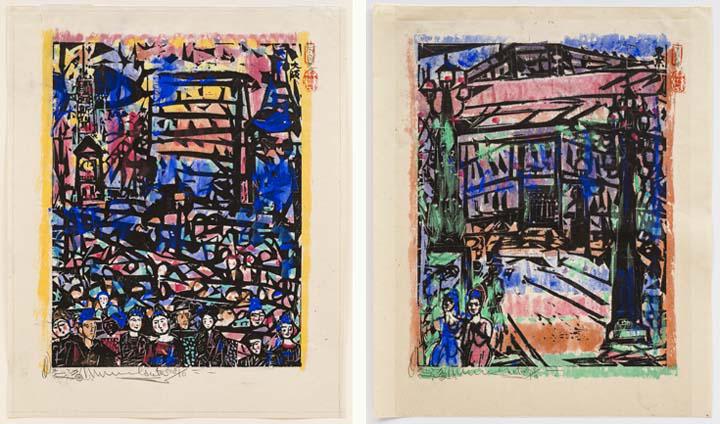Shiko Munakata: A Way of Seeing
Shiko Munakata: A Way of Seeing, a new presentation of nearly 100 innovative works by the celebrated artist Shiko Munakata (1903–1975), goes on view December 10 at Japan Society. Primarily known for his expressive woodblock prints in black on white paper, this exhibition reveals the breadth of Munakata’s oeuvre, which spanned from prints to calligraphy, sumi ink paintings, watercolors, lithography, and ceramics. Above: Shiko Munakata, detail of Muk-machi: Crossing Point of Highways, from the Tkaid Series, 1964.
A highlight of the exhpbition is the complete set of Munakata’s Tokaido Series (1964)
Above: Shik Munakata, Hara, from the Tkaid Series, 1964. Photograph by Nicholas Knight. Courtesy of Japan Society
Munakata also worked in vibrant color on large-scale wood-block prints, using a palette inspired by the lantern floats in the annual Nebuta Festivals of his native Aomori Prefecture. No matter the medium, Munakata’s artistic explorations were characterized by a spirited curiosity and relentless experimentation. He incorporated diverse sources and inspiration in his dynamic works, including Japanese folk tales, Buddhism, Western literature and poetry, and nature motifs.
With his bold, spontaneous lines, Munakata developed an innovative style that revolutionized the woodblock print medium. Associated with the twentieth-century sosaku hanga (creative prints) movement and recognized by leaders of the mingei (folk craft) movement of the same era, Munakata expanded the traditional ukiyo-e small-scale, and generally vertical format, to create large-scale pieces that modernized the centuries-old practice of woodblock prints. Above left: Shik Munakata, Osaka: The Evening of the Crowded City, from the Tkaid Series, 1964. Photograph by Nicholas Knight, courtesy of Japan Society; right: Shik Munakata, Tokyo: The Starting Point, from the Tkaid Series, 1964. Photograph by Nicholas Knight. Courtesy of Japan Society

Based in New York City for his six-month visit, Munakata lectured and held exhibitions throughout the U.S. accompanied by Beate Sirota Gordon (1923–2014), a women’s rights advocate and contributor to the writing of the Constitution of Japan following World War II. Gordon was the founding Director of Performing Arts at Japan Society and she also served as Munakata’s interpreter, ultimately becoming a lifelong friend. Munakata returned to New York in 1965, again under the auspices of Japan Society, and it was then that he donated many of the works that form the Museum's core institutional collection. Organized from Japan Society’s collection—which includes the largest Munakata collection in the United States—the exhibition explores the imagination and practice of this important twentieth-century artist. Photo above right, courtesy of Yoriko Ishii

Shiko Munakata: A Way of Seeing continues through March 20 at Japan Society, 333 East 47th Street, NY, NY Info
Shiko Munakata (1903-1975), born in the northern Aomori Prefecture as one of fifteen children to a blacksmith, began his career as a self-taught oil painter. In 1924, at the age of twenty-one, Munakata moved to Tokyo to pursue an artistic career where, upon seeing a woodblock print by Sumio Kawakami, he changed course and became active in the woodblock print community. He continued printmaking throughout World War II and was awarded prizes in international exhibitions and biennials held in Lugano (1952), Sao Paulo (1955), and Venice (1956). Visiting the United States in 1959 at the invitation of Japan Society as part of its Print Artists Program, Munakata spent six months lecturing and exhibiting his work throughout the country. Munakata’s accolades continued, including the Medal of Honor (1963), the Asahi Shimbun Prize (1964), and the Order of Culture (1970), Japan’s highest honor in the arts. Munakata was famously myopic, and in 1960 he lost the use of his left eye completely. Despite this, he continued producing work at a prolific output until his death in 1975. Above left: Shik Munakata, Self-portrait with Hudson River, 1959. Photograph by Nicholas Knight. Courtesy of Japan Society






